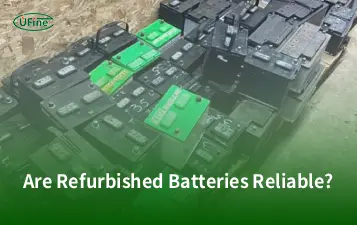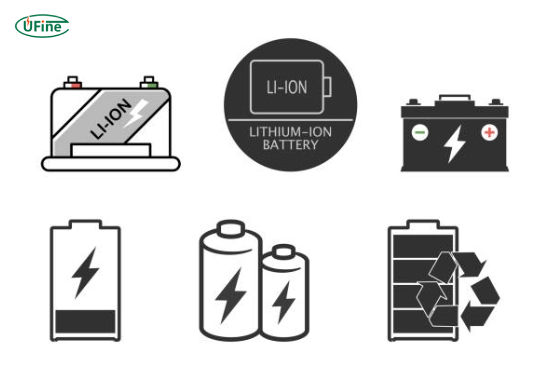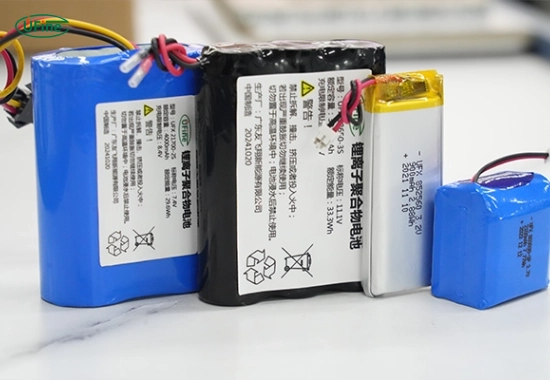
- Part 1. What is a lithium-ion battery symbol?
- Part 2. Why does the lithium-ion battery symbol matter in engineering?
- Part 3. What does the lithium-ion battery symbol look like?
- Part 4. What are the different lithium-ion battery symbol variations?
- Part 5. Terminals and polarity: What do the + and - symbols mean?
- Part 6. Battery circuit symbols and connections in diagrams
- Part 7. Understanding battery chemical labels
- Part 8. Voltage, shape, and form factor labels
- Part 9. How to use lithium-ion battery symbols in engineering design
- Part 10. Regulatory standards for lithium-ion battery symbols
- Part 11. FAQs about lithium-ion battery symbols
What does the lithium-ion battery symbol mean in engineering design and safety? The symbol identifies a battery or device that uses lithium-ion chemistry. It helps engineers, technicians, and manufacturers ensure proper usage, safety, and compliance with global standards. This symbol is critical for product labeling, electrical schematics, shipping documents, and recycling.
This guide will explore everything engineers must know about lithium-ion battery symbols. We will cover symbol variations, terminal markings, circuit diagrams, battery labels, chemical compositions, voltage tags, and real-world applications.
Part 1. What is a lithium-ion battery symbol?
The lithium-ion battery symbol is a visual icon representing a battery that operates using lithium-ion chemistry. It is widely used in consumer electronics, electric vehicles, energy storage systems, and medical technology.
The symbol typically shows a battery shape with a lightning bolt or spark inside. It may also include the text “Li-ion” or “Lithium-ion.” This symbol appears in schematics, user manuals, packaging, and the battery.
It serves multiple purposes, such as identifying the battery type, alerting users to potential hazards, and ensuring compliance with global safety standards.
Part 2. Why does the lithium-ion battery symbol matter in engineering?
The symbol is essential for several engineering functions:
Safety
Lithium-ion batteries are powerful energy sources. If damaged or misused, they can overheat or catch fire. The symbol acts as a warning and safety reminder.
Product design
In layout diagrams and PCB schematics, the symbol helps identify where the battery is connected, what voltage it supplies, and how it interacts with other components.
Maintenance
Technicians rely on the symbol to quickly identify the type of battery used, which guides safe replacement and troubleshooting.
Compliance
Many global standards require the lithium-ion battery symbol on products, packaging, and shipping documents.
Part 3. What does the lithium-ion battery symbol look like?
The symbol can vary in design, but it usually includes:
- A rectangular battery shape
- A lightning bolt or electric spark inside the battery
- The label Li-ion is placed near the icon
- Optional warning elements such as exclamation marks or hazard triangles
Some variants include a recycling icon or voltage information beside the primary symbol.
Part 4. What are the different lithium-ion battery symbol variations?
Generic symbol
A simple battery icon with a bolt or spark. Most commonly used in consumer electronics and casual labeling.
IEC and ISO standard symbols
Used in industrial and professional contexts. These symbols follow strict design rules, including safety icons, chemical identifiers, or hazard markers.
UN transport symbol
Used for shipping lithium-ion batteries. This includes a battery with flames and a red-bordered label to warn of fire risk.
PCB schematic symbol
The symbol is simplified in electrical schematics into a series of lines representing battery cells with a + and – terminal. It is typically labeled with Li-ion and voltage (e.g., 3.7V).
Smart battery symbol
Some modern devices include a symbol with a microchip icon or data port indicator to show the use of smart battery management systems.
Part 5. Terminals and polarity: What do the + and – symbols mean?
Lithium-ion batteries are marked with positive (+) and negative (-) terminal symbols in almost every context. These indicate the direction of current flow and are crucial in circuit design.
Battery label
- + (Positive terminal): Usually connected to the red wire or VCC
- – (Negative terminal): Usually connected to the black wire or ground (GND)
Schematic usage
The battery symbol in circuit diagrams includes these terminal markings to help engineers correctly design circuits. Reversing polarity can damage components or cause safety hazards.
PCB layout
The silkscreen or copper layer of the PCB often includes + and – markings near the battery connector pads or headers.
Installation guide
Correct polarity identification prevents reverse-connection, which may lead to short circuits, overheating, or battery failure.
Part 6. Battery circuit symbols and connections in diagrams
In schematics, a lithium-ion battery is typically represented by:
- Two or more parallel lines of unequal length
- The longer line represents the positive terminal
- The shorter line represents the negative terminal
Additional annotations may include:
- Li-ion or Lithium-ion
- Voltage rating (e.g., 3.7V)
- Capacity (e.g., 2600mAh)
- Number of cells (e.g., 1S, 2S, 3S for cell series count)
These designations help identify how much power the battery supplies and how to integrate it with charging circuits or load components.
Part 7. Understanding battery chemical labels
Lithium-ion batteries come in different chemical compositions, and the labeling may reflect this. Common types include:
- LiCoO₂ (Lithium Cobalt Oxide): High energy density, common in phones and laptops
- LiFePO₄ (Lithium Iron Phosphate): Stable and safe, used in EVs and solar systems
- LiMn₂O₄ (Lithium Manganese Oxide): High thermal stability
- NMC (Nickel Manganese Cobalt Oxide): Balanced performance, used in power tools and EVs
When the lithium ion battery symbol is used, it may be accompanied by these chemical identifiers, especially in technical documentation.
Understanding these chemistries helps engineers choose the right battery for the right application.
Part 8. Voltage, shape, and form factor labels
Besides the symbol itself, lithium-ion batteries are labeled with information such as:
Voltage
Each lithium-ion cell typically has a nominal voltage of 3.6V or 3.7V. When fully charged, the voltage can reach 4.2V. Engineers must consider this when designing circuits.
Battery packs may be labeled like:
- 1S (single cell): 3.7V
- 2S (two cells in series): 7.4V
- 3S (three cells in series): 11.1V
Capacity
Measured in mAh (milliamp-hours) or Ah (amp-hours). This determines how long the battery can supply power.
Shape and size
Lithium-ion batteries come in different shapes:
- Cylindrical (e.g., 18650)
- Prismatic
- Pouch cells
The label may include size codes (18650) to help engineers select or replace the correct battery type.
Part 9. How to use lithium-ion battery symbols in engineering design
To correctly use the symbol in your design:
- Place the symbol clearly in schematics and block diagrams
- Label the voltage and chemistry near the symbol
- Ensure terminal polarity is marked with + and –
- Add safety notes if the battery is not user-replaceable
- Use the correct symbol variation for packaging, shipping, or user manuals
Consistent use of symbols and labels helps prevent errors and improve communication when working in teams.
Part 10. Regulatory standards for lithium-ion battery symbols
Several organizations define proper usage of lithium-ion battery symbols:
- IEC 60417 defines graphical symbols for use on equipment. Commonly used in electrical product design.
- ISO 7010 Covers safety symbols, especially for workplace and industrial use.
- UN 3480 / UN 3481 specifies labeling for shipping standalone lithium-ion batteries or those contained in equipment.
- ANSI Y32 / IEEE 315 defines standard electrical and electronic schematic symbols used in North America.
- RoHS / WEEE European directives require clear labeling and safe disposal symbols for batteries.
Using the correct standard ensures your design is accepted in global markets and meets all safety and environmental laws.
Part 11. FAQs about lithium-ion battery symbols
What does the lithium-ion battery symbol indicate?
It indicates that a product or component uses a lithium-ion battery. It helps ensure proper handling, safety, and regulatory compliance.
Are positive and negative terminals always labeled?
Yes. The + and – symbols are critical for identifying battery polarity. Reversing these can cause circuit damage or battery failure.
What voltage is shown on lithium-ion battery symbols?
Most lithium-ion cells are labeled with a nominal voltage of 3.6V or 3.7V. Battery packs may show higher voltages based on the number of cells.
Can I use the same symbol for all lithium-ion batteries?
You can use a standard symbol, but to avoid confusion, it is best to include additional labels such as chemistry, capacity, and voltage.
What happens if I ignore proper labeling?
Improper labeling can lead to safety risks, failed compliance checks, and even legal penalties. Always use the correct lithium-ion battery symbol and accompanying labels.
Related Tags:
More Articles

Are Refurbished Batteries Safe and Reliable Today?
Explore the reliability of refurbished batteries with expert insights on testing, cycle life, performance, and key factors affecting longevity.
How to Convert M6/M8 Lithium Battery Terminals to Standard Post Terminals?
Convert M6/M8 lithium battery terminals to standard SAE posts safely. Learn required adapters, installation tips, and ensure stable, reliable conductivity.
Which LiPo Charger Balancer Is Best for Your Battery?
Understand why balancing is essential for multi-cell LiPo charging. Prevent swelling, extend lifespan, and choose the right LiPo balancer.
Can You Replace a 7.2v Nimh Battery and Charger with a Lithium System?
Upgrade 7.2V NiMH to lithium? Learn risks, safety checks, runtime gains, charging changes, and when the upgrade makes financial sense for RC, tools, devices.
Which Bike Battery is Best for a 250W Commuter E-Bike?
Learn how to choose the best battery for your 250W commuter e-bike. Compare sizes, chemistry, and performance for optimal daily use.




